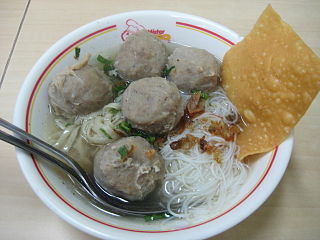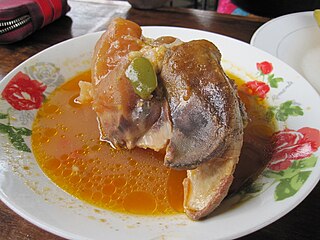
Indonesian cuisine is a collection of various regional culinary traditions that formed the archipelagic nation of Indonesia. There are a wide variety of recipes and cuisines in part because Indonesia is composed of approximately 6,000 populated islands of the total 17,508 in the world's largest archipelago, with more than 1,300 ethnic groups.

Noodle soup refers to a variety of soups with noodles and other ingredients served in a light broth. Noodle soup is a common dish across East Asia, Southeast Asia and the Himalayan states of South Asia. Various types of noodles are used, such as rice noodles, wheat noodles and egg noodles.

Chinese Indonesian cuisine is characterized by the mixture of Chinese with local Indonesian style. Chinese Indonesians, mostly descendant of Han ethnic Hokkien and Hakka speakers, brought their legacy of Chinese cuisine, and modified some of the dishes with the addition of Indonesian ingredients, such as kecap manis, palm sugar, peanut sauce, chili, santan and local spices to form a hybrid Chinese-Indonesian cuisine. Some of the dishes and cakes share the same style as in Malaysia and Singapore, known as Nyonya cuisine by the Peranakan.

Fried noodles are common throughout East Asia, Southeast Asia and South Asia. Many varieties, cooking styles, and ingredients exist.

Bakmi or bami is a type of wheat based noodles derived from Chinese cooking tradition. It was brought to Indonesia by Chinese immigrants from Southern Chinese provinces like Fujian. It is typically prepared seasoned in soy sauce and topped with pork products, which is often substituted for other protein sources in predominantly Muslim Indonesia. Chinese-style wheat noodles has become one of the most common noodle dishes, especially in Southeast Asian countries which have significant Chinese populations and known by various names.

Bakso or baso is an Indonesian meatball, or a meat paste made from beef surimi. Its texture is similar to the Chinese beef ball, fish ball, or pork ball. The word bakso may refer to a single meatball or the complete dish of meatball soup. Mie bakso refers to bakso served with yellow noodles and rice vermicelli, while bakso kuah refers to bakso soup served without noodles.

Javanese cuisine is the cuisine of Javanese people, a major ethnic group in Indonesia, more precisely the province of Central Java, Yogyakarta and East Java.

Mung bean sprouts are a culinary vegetable grown by sprouting mung beans. They can be grown by placing and watering the sprouted beans in the shade until the hypocotyls grow long. Mung bean sprouts are extensively cultivated and consumed in East and Southeast Asia and are very easy to grow, requiring minimal care other than a steady supply of water. They are often used in school science projects.

Sundanese cuisine is the cuisine of the Sundanese people of Western Java, and Banten, Indonesia. It is one of the most popular foods in Indonesia. Sundanese food is characterised by its freshness; the famous lalab eaten with sambal and also karedok demonstrate the Sundanese fondness for fresh raw vegetables. Unlike the rich and spicy taste, infused with coconut milk and curry of Minangkabau cuisine, the Sundanese cuisine displays the simple and clear taste; ranged from savoury salty, fresh sourness, mild sweetness, to hot and spicy.

A meatball is ground meat rolled into a ball, sometimes along with other ingredients, such as bread crumbs, minced onion, eggs, butter, and seasoning. Meatballs are cooked by frying, baking, steaming, or braising in sauce. There are many types of meatballs using different types of meats and spices. The term is sometimes extended to meatless versions based on vegetables or fish; the latter are also commonly known as fish balls.

Soto mie, Soto mi, or Mee soto is a spicy Indonesian noodle soup dish commonly found in Indonesia, Malaysia, and Singapore. Mie means noodle made of flour, salt and egg, while soto refers to Indonesian soup. In Indonesia, it is called soto mie and is considered one variant of soto, while in Malaysia and Singapore it is called mee soto.

Mie kocok, is an Indonesian beef noodle soup, specialty of Bandung city, West Java. The dish consists of noodles served in rich beef consommé soup, kikil, bean sprouts and bakso, kaffir lime juice, and sprinkled with sliced fresh celery, scallion and fried shallot. Some recipes might add beef tripe.

Mie kangkung, is an Indonesian vegetable noodle soup with kangkung, usually served with bakso meatball and mushroom. It is of a specialty of Betawi cuisine, Jakarta, Indonesia. The yellow egg noodles come with a brown-colored thick soup, made of chicken or beef broth, which is thickened with tapioca, spiced and mixed with garlic and kecap manis. Other ingredients include bakso meatballs, bean sprouts, mushroom, hard boiled quail eggs and sprinkled with bawang goreng and added with dash of kaffir lime juice and sambal.

Betawi cuisine is rich, diverse and eclectic, in part because the Betawi people that create them were composed from numbers of regional immigrants that came from various places in the Indonesian archipelago, as well as Chinese, Indian, Arab, and European traders, visitors and immigrants that were attracted to the port city of Batavia since centuries ago.

Mie aceh or mi aceh is an Acehnese curried spicy noodle dish. The dish is often described as Aceh style spaghetti.

Cow's trotters are the feet of cattle. The cuts are used in various dishes around the world, especially in Asian, African, French, and the Caribbean cuisine. Latin American cuisine also uses cow's trotters for several traditional dishes.

Indonesian noodles are a significant aspect of Indonesian cuisine which is itself very diverse. Indonesian cuisine recognizes many types of noodles, with each region of the country often developing its own distinct recipes.

Mie kopyok, is an Indonesian noodle soup, specialty of Semarang city, Central Java. The dish consists of noodles served in garlic soup, slices of fried tofu, lontong, bean sprouts, and crushed of kerupuk gendar, sprinkled with sliced fresh celery, and fried shallot. It is served with kecap manis on top. Mie kopyok was mostly peddled with pushed food carts from one sub-district to another, but now, it can be found in the downtown of Semarang with a permanent building.




















